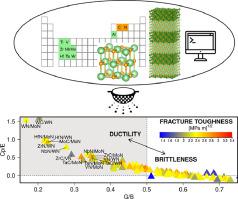Acta Materialia ( IF 8.3 ) Pub Date : 2021-01-04 , DOI: 10.1016/j.actamat.2020.116615 Nikola Koutná , Alexander Brenner , David Holec , Paul H. Mayrhofer

|
Superlattices—alternating coherently grown materials of nm thicknesses—proved their potential for enhancing typically antagonistic properties of ceramics: ductility, hardness, and fracture toughness. Material selection, however, is far from trivial, as superlattice films do not simply combine mechanical properties of their layer components. Here we employ high-throughput density functional theory calculations to develop design guidelines for nanolaminates combining cubic transition metal nitride and/or carbide ceramics. Out of 153 MX/M*X* superlattices (M, M* = Al, Ti, Zr, Hf, Nb, V, Ta, Mo, W, and X, X* = C, N) 145 are chemically and mechanically stable and most often contain vacancies on the non-metallic sublattice. Superior ductility together with moderate-to-high fracture toughness and interface strength (above that of the cubic TiN) narrow the set of perspective candidates. Key ingredients promoting the interface-induced enhancement of hardness and/or fracture toughness are lattices parameter and shear modulus mismatch of the layer components. Adding the requirement of phonon stability yields MoN/M*N, M* = Nb, Ta, Ti; TiN/WN (nitrides); HfC/M*N, M* = Mo, W; NbC/M*N, M* = Mo, W; TaC/M*N, M* = Mo, W; VC/M*N, M* = Hf, Ta, Zr (carbonitrides); as the top candidates for novel superlattice films.
中文翻译:

高通量第一性原理寻找具有改善的延展性和抗断裂性的陶瓷超晶格
超晶格(交替相干生长的厚度为nm的材料)证明了它们增强陶瓷的典型拮抗性能(延展性,硬度和断裂韧性)的潜力。然而,材料选择绝非易事,因为超晶格薄膜不能简单地结合其层成分的机械性能。在这里,我们采用高通量密度泛函理论计算来开发结合了立方过渡金属氮化物和/或碳化物陶瓷的纳米层压板的设计指南。在153个MX / M * X *超晶格(M,M * = Al,Ti,Zr,Hf,Nb,V,Ta,Mo,W和X,X * = C,N)中145是化学和机械稳定的并且大多数情况下在非金属亚晶格上包含空位。优异的延展性以及中等至较高的断裂韧性和界面强度(高于立方氮化钛),可以缩小候选范围。促进界面诱导的硬度和/或断裂韧性增强的关键成分是晶格参数和层组分的剪切模量不匹配。增加对声子稳定性的要求,得出MoN / M * N,M * = Nb,Ta,Ti;TiN / WN(氮化物);HfC / M * N,M * = Mo,W;NbC / M * N,M * = Mo,W;TaC / M * N,M * = Mo,W;VC / M * N,M * = Hf,Ta,Zr(碳氮化物);作为新型超晶格电影的最佳候选人。钽,钛 TiN / WN(氮化物);HfC / M * N,M * = Mo,W;NbC / M * N,M * = Mo,W;TaC / M * N,M * = Mo,W;VC / M * N,M * = Hf,Ta,Zr(碳氮化物);作为新型超晶格电影的最佳候选人。钽,钛 TiN / WN(氮化物);HfC / M * N,M * = Mo,W;NbC / M * N,M * = Mo,W;TaC / M * N,M * = Mo,W;VC / M * N,M * = Hf,Ta,Zr(碳氮化物);作为新型超晶格电影的最佳候选人。











































 京公网安备 11010802027423号
京公网安备 11010802027423号